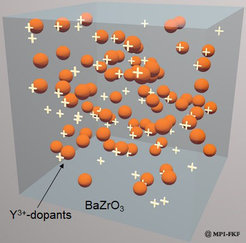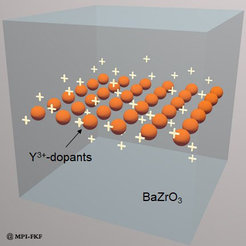Two-dimensional Doping of Proton Conductors:
BaZrO3-based Heterostructures
Ionic conducting heterostructures have recently generated interest, not only for revealing interfacial effects in solid state ionics; but also for their potential deployment in clean energy technologies such as solid oxide fuel cells (SOFC). Reducing the current operating temperature of SOFCs using thin film electrolytes is one of the main current research issues.
Acceptor-doped BaZrO3 has been widely investigated, particularly for applications in clean energy technologies, most importantly for intermediate temperature protonic ceramic fuel cells. However, only homogenous introduction of effectively charged foreign elements in the form of point defects has been explored [Figure 1]. While two-dimensional (2D) doping by substituting an entire single layer has been frequently used for classic semiconductors, it is not a common doping strategy in ionic systems.
As now reported in Advanced Energy Materials, 1600157 (2020), we demonstrate the first application of 2D doping to ion conductors, specifically to perovskite proton conductor BaZrO3–based heterostructures. This 2D doping strategy replaces an entire layer of the crystal (Ba-O-layer) by a heterovalent layer (Y-O-layer), and the resulting charge carriers are located in the immediate vicinity [Figure 2].
We use epitaxial BaZrO3–BaYOx heterostructures and in particular 2D doping of BaZrO3 by yttrium [Figure 3]. We chose BaZrO3, the state-of-the-art ceramic proton conductor, as host material with the purpose of investigating the effect of 2D ordering of the Y dopants on the proton transport and hydration properties. After hydration, the heterostructures show greatly enhanced proton conductivities. Figure 4 shows the conductivities of [(BaZrO3)m–(BaYOx)1]n/2 superlattices as function of the number of YOx/BaOx interfaces. As expected, the conductivities of the superlattices increase progressively with increasing number of interfaces. Our results not only lead to fundamental insight into the pros and cons of 2D doping of ion conductors, but also help define a pathway towards improving protonic devices.
This research was done in collaboration with Rotraut Merkle and Joachim Maier of the Department for Physical Chemistry of Solids, and Yi Wang and Peter A. van Aken of the StEM group.

Illustration of homogeneous introduction of effectively charged foreign elements in the form of point defects, where aliovalent substitutional impurities introduce a negative effective charge that is compensated by positive compensating charges (blue: BaZrO3, orange: Y cations).

Illustration of 2D doping strategy, where substitutional impurities replace an entire layer in the host compensated by space charges (blue: BaZrO3, orange: Y cations).
![A typical cross-sectional high-resolution scanning transmission electron microscopy image of a representative [(BaZrO3)6–(BaYOx)1]10 superlattice grown on MgO substrate. The interface between the substrate and deposited layers is coherent, and no misfit dislocations are detected along the interface.](/7332042/original-1751895736.jpg?t=eyJ3aWR0aCI6MjQ2LCJvYmpfaWQiOjczMzIwNDJ9--49007a51a97584ce1f0759fcd295a9e4518d64ee)
A typical cross-sectional high-resolution scanning transmission electron microscopy image of a representative [(BaZrO3)6–(BaYOx)1]10 superlattice grown on MgO substrate. The interface between the substrate and deposited layers is coherent, and no misfit dislocations are detected along the interface.
![Proton conductivities of the [(BaZrO3)m–(BaYOx)1]n/2 superlattices (sl 0%) with various numbers n of YOx/BaOx interfaces (n = 2, 16, 32, 48, 60, and 120, counting the top and bottom interfaces) and of the undoped BaZrO3 films (hf 0%). All films are grown on MgO substrates and the overall thickness is the same for all samples (80 nm).](/7332065/original-1751895736.jpg?t=eyJ3aWR0aCI6MjQ2LCJvYmpfaWQiOjczMzIwNjV9--b158394bfc8dd7c19922ac30b1088c01e0a404d2)
Proton conductivities of the [(BaZrO3)m–(BaYOx)1]n/2 superlattices (sl 0%) with various numbers n of YOx/BaOx interfaces (n = 2, 16, 32, 48, 60, and 120, counting the top and bottom interfaces) and of the undoped BaZrO3 films (hf 0%). All films are grown on MgO substrates and the overall thickness is the same for all samples (80 nm).


![Figure 3:A typical cross-sectional high-resolution scanning transmission electron microscopy image of a representative [(BaZrO3)6–(BaYOx)1]10 superlattice grown on MgO substrate. The interface between the substrate and deposited layers is coherent, and no misfit dislocations are detected along the interface. A typical cross-sectional high-resolution scanning transmission electron microscopy image of a representative [(BaZrO3)6–(BaYOx)1]10 superlattice grown on MgO substrate. The interface between the substrate and deposited layers is coherent, and no misfit dislocations are detected along the interface.](/7332042/original-1751895736.jpg?t=eyJ3aWR0aCI6MzQxLCJmaWxlX2V4dGVuc2lvbiI6ImpwZyIsIm9ial9pZCI6NzMzMjA0Mn0%3D--3a209eafc0b5c853657b438091c48f7380571189)
![Figure 4:Proton conductivities of the [(BaZrO3)m–(BaYOx)1]n/2 superlattices (sl 0%) with various numbers n of YOx/BaOx interfaces (n = 2, 16, 32, 48, 60, and 120, counting the top and bottom interfaces) and of the undoped BaZrO3 films (hf 0%). All films are grown on MgO substrates and the overall thickness is the same for all samples (80 nm). Proton conductivities of the [(BaZrO3)m–(BaYOx)1]n/2 superlattices (sl 0%) with various numbers n of YOx/BaOx interfaces (n = 2, 16, 32, 48, 60, and 120, counting the top and bottom interfaces) and of the undoped BaZrO3 films (hf 0%). All films are grown on MgO substrates and the overall thickness is the same for all samples (80 nm).](/7332065/original-1751895736.jpg?t=eyJ3aWR0aCI6MzQxLCJmaWxlX2V4dGVuc2lvbiI6ImpwZyIsIm9ial9pZCI6NzMzMjA2NX0%3D--93e3e4c69c1e9d0fd937572e0c6c4e8dbd83133b)